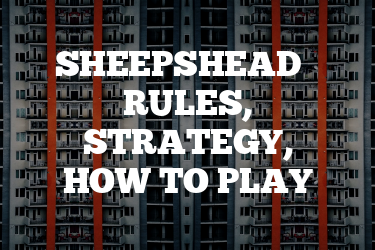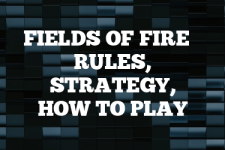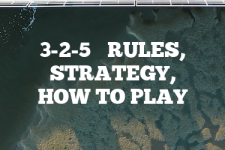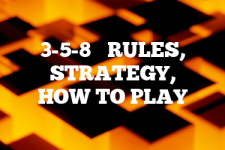Sheepshead: A Reference Guide to the Rules, Instructions & Winning Strategy you need to know
Introduction
Sheepshead, originating from Germany, is a trick-taking game that has been around since the late 18th century. It’s played with a deck of 32 cards, which is a standard 52-card deck with all cards below the 7s removed. I find it’s an interesting variant to play if you’re into trick-taking games with a restricted deck.

This game is played with a unique deck of 32 cards. Unlike other common card games that typically use a full 52-card deck, Sheepshead players remove all cards that are below the 7s. This means that the 2s, 3s, 4s, 5s, and 6s from all four suits – hearts, diamonds, clubs, and spades – are taken out of the deck before the game begins. The remaining cards comprise of 7s through 10s, plus the face cards – jacks, queens, kings, and aces.
The rules and gameplay of Sheepshead can vary, but the basic goal is always to accumulate the most points through winning ‘tricks’, a common term in trick-taking games referring to a round of play where each player contributes a card, and the highest card wins. The player who takes the final trick also gets any remaining cards in the deck.
The unique deck size and the trick-taking element make Sheepshead a game of strategy and skill. Players must carefully consider which cards to play in each round, keeping in mind what has already been played and what their opponents might still have in their hands.
In addition to being a popular pastime in Germany, Sheepshead has also found a following in other parts of the world, particularly in areas with a significant German-American population. Despite being around for centuries, the game continues to entertain and challenge players.
Quick Tip for Sheepshead
Always remember, in Sheepshead, the Queens and Jacks are the highest cards, not the Aces and Kings as in many other card games.
Rules for playing Sheepshead
Sheepshead is typically played with five players, although variations can accommodate anywhere from two to eight players. The game revolves around the concept of ‘trick-taking’, where each player plays a card and the player who plays the highest card wins the trick. The game also features a unique scoring system, where the goal is to score the most points by taking tricks containing valuable cards.
The Dealing
The dealer shuffles the deck and deals six cards to each player in batches of three. The remaining cards are placed face down in the center of the table to form the ‘blind’.
How to Play Sheepshead
- Setup: Players sit in a circle and the dealer is chosen at random. The dealer shuffles the deck and deals the cards as described above.
- Gameplay: The player to the left of the dealer leads the first trick. Players must follow suit if possible, otherwise they can play any card. The player who plays the highest card of the led suit, or the highest trump if trumps were played, wins the trick.
- End of the Game and Scoring: The game ends when all tricks have been played. Players count the points in their tricks, with each Ace, Ten, King, Queen, and Jack worth 11, 10, 4, 3, and 2 points respectively. The player with the most points wins.
How to Win at Sheepshead
Winning at Sheepshead requires a good balance of strategy, skill, and a bit of luck. It’s important to keep track of which cards have been played and to make the most of your high cards. Also, knowing when to play your trump cards can be the difference between winning and losing a game.
Maximizing the potential of your high cards and utilizing them at opportune moments can greatly swing the game in your favor. Additionally, the strategic deployment of your trump cards could be the pivotal factor that differentiates a triumphant game from a lost one. This game is not just about the cards you are dealt, but how you play them.
Strategies for playing Sheepshead
One of the best strategies in Sheepshead is to try and control the game by winning tricks early on. This allows you to dictate the flow of the game and put pressure on your opponents. Also, try to keep a mental note of which cards have been played, as this can give you an advantage in the later stages of the game.
Winning tricks early also has another benefit. It allows you to hold on to your higher value cards for the later stages of the game. This can provide a significant advantage as the game progresses. The longer you hold on to your high-value cards, the more likely it is that your opponents will be forced to play their own high-value cards in an attempt to win tricks. This can leave them with fewer options in the later stages of the game.
Another important strategy in Sheepshead is to keep a mental note of which cards have been played. This requires a good memory, but it can provide a significant advantage. By keeping track of which cards have been played, you can gain a better understanding of which cards are likely to be played in the future. This can help you to predict your opponents’ moves and plan your own strategy accordingly.
In addition, knowing which cards have been played can also help you to make more informed decisions when it comes to choosing which cards to play yourself. For example, if you know that most of the high-value cards have already been played, you may decide to play one of your own high-value cards in the hope of winning a trick. On the other hand, if you know that there are still a lot of high-value cards left to be played, you might decide to hold on to your own high-value cards for a little bit longer.
Overall, the best strategy in Sheepshead is to win tricks early on and to keep a mental note of which cards have been played. These tactics can help you to control the game, put pressure on your opponents, and give you an advantage in the later stages of the game.
Game Variations
There are several variations of Sheepshead, including ‘Leaster’, where the player who takes the least number of points wins, and ‘Doubler’, where the points for each game are doubled.
Scenarios for Sheepshead
There are many scenarios in Sheepshead that can turn the tide of the game. For example, if you’re dealt a hand with several high cards, you might want to play aggressively and try to win as many tricks as possible. On the other hand, if you’re dealt a poor hand, you might want to play conservatively and try to avoid taking tricks with high point cards.
Frequently Asked Questions about playing Sheepshead game
- What happens if two players play the same card? In Sheepshead, the first played card wins.
- Can you play Sheepshead with more than five players? Yes, there are variations of Sheepshead that can accommodate up to eight players.
- What is the ‘blind’ in Sheepshead? The ‘blind’ is the pile of cards left over after the dealer has dealt the cards to the players.
External Links
Sheepshead is strangely popular in Wisconsin gaming communities – Jordyn over at the Journal Sentinel online gives a good account of it.

Eve Brownlee was a gamer before gaming communities on the internet were a thing. Eve grew up playing traditional, standard deck card games like Rummy and Bezique, taking an interest in the classics Backgammon and Chess. Parlor card games like Bridge continue to keep Eve active in the community. After a long career, primarily in horticulture for USDA in Maryland, Eve now travels and writes on The Pineapple (pineapples.info) and contributes to Quora/Pinterest topics. Contact Eve via email.



